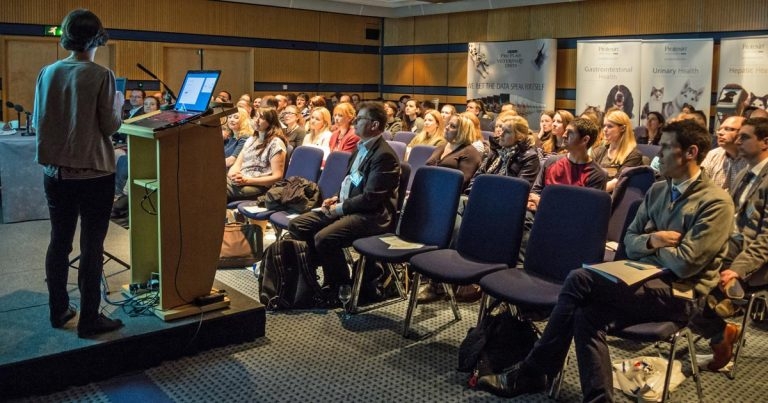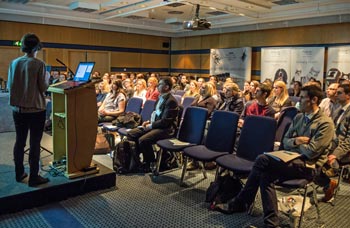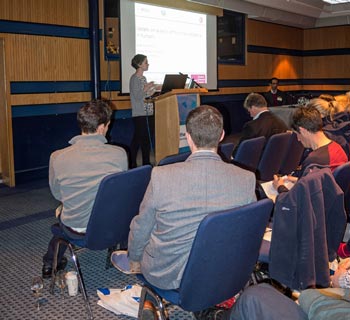10 Jul 2017
Andrew Kent reports on the small animal internal medicine CPD, which took place on 5 April at the ICC in Birmingham.

The pre-BSAVA Small Animal Medicine Society spring meeting brought together specialists, advanced practitioners and vets with shared clinical interests.
The pre-BSAVA spring meeting of the Small Animal Medicine Society (SAMSoc) brings together specialists, advanced practitioners and veterinary surgeons with an interest in medicine to hear about a range of topics across the field of internal medicine.

The day, on 5 April, at the ICC in Birmingham, was kicked off by cardiology specialist Mike Martin talking about collapse in the dog. Mr Martin is always a popular speaker and allowed us to benefit from his huge experience in this area with an amusing and thought-provoking lecture.
Worryingly, up to 30% of humans treated for epilepsy have a cardiogenic cause for their clinical signs (such as high-degree atrioventricular block). Are vets doing better than medics on this front? Mr Martin challenged our preconceptions of what makes an episode more likely to be cardiac rather than neurological, giving very practical advice we can all put to use in our patients.
The overlap of clinical signs can be confusing and highlights the importance of detailed history taking (tailored to account for the owner’s inherent perceptions). Questioning as to a pet’s consciousness may yield misleading results, while responsiveness may be more readily quantifiable for the owner.
Most interesting for the author, Mr Martin highlighted opisthotonos (rigid extension of the head, neck and forelimbs) may be more commonly associated with a cardiac-origin cerebral hypoxia, rather than an epileptic seizure.
Mr Martin’s talk served as an important reminder of the importance to consider heart disease as a potential cause for syncope/seizure-like episodes, even when the owner’s description may have classic characteristics of a neurological disorder.
Mr Martin was followed by another hugely experienced speaker, Ed Hall, the only RCVS-recognised specialist in gastroenterology. Many of us perform gastrointestinal biopsy every day and Prof Hall had been invited to review the information we might hope to achieve from this technique. He gave us an excellent overview of this topic, along with some thoughts on future directions in gastroenterology.
Prof Hall stressed careful case selection and timing of endoscopy were vital to ensuring the information gained could offer useful diagnostic or prognostic information. The limitations of histopathology and the weak correlation with disease severity mean endoscopy should be part of a coherent case approach, including therapeutic diet trials (and possibly antibiotic trials).
After a short coffee break, the day took a more youthful turn with Chris Scudder talking about feline acromegaly. Mr Scudder is undertaking a PhD in this area and is, consequently, at the forefront of this disease. His insight was fascinating and brought us up to date with the latest thoughts on the understanding and management of this disease.
While diabetic cats are familiar to all in practice, Mr Scudder’s experience suggests acromegaly may also be a more common complication than expected. Up to 25% of UK cats with diabetes may have concurrent acromegaly complicating their glucose control – hypophysectomy is recommended to treat this problem. Greater awareness may help promote the development of more effective medical management options, such as pasireotide, leading to improved management of these tricky cases.
This topic led nicely to the presentation on management of intracranial tumours from Thomas Harcourt-Brown. These are relatively common tumours in cats and dogs, and something we all encounter on a regular basis. Nevertheless, the evidence base for treatment decisions is sparse, and Mr Harcourt-Brown gave an impassioned appeal for greater data pooling and standardisation of inclusion/exclusion criteria and outcome measures. Mr Harcourt-Brown has pioneered some advanced techniques to manage intra-axial masses, including intralesional chemotherapy. This intriguing area needs further investigation and adaptation, and may yet offer a therapeutic potential to our patients.
The SAMsoc case report competition was the final event of the morning.
There were three excellent presentations of unusual cases, including a German shepherd dog with a miniscule ectopic parathyroid tumour (Elsa Edery) and a boxer with recurrent neospora pneumonitis (Fiona Whitworth). The competition was very close, but won by Rebecca Geddes from the RVC. Dr Geddes described the detailed work-up of a cat with a urea cycle enzyme deficiency, provoking hyperammonaemia and associated neurological clinical signs.
The 2017 SAMsoc travel scholarship was awarded to Sara Ravicini. She used the money to attend the American College of Veterinary Internal Medicine 2017 Forum, which was held in Washington, where she also presented an abstract comparing the use of a multi-drug protocol against glucocorticoids alone for the treatment of idiopathic immune-mediated polyarthritis. We look forward to hearing more about Miss Ravicini’s experiences at next year’s meeting.
The lunch break provided a great opportunity to catch up with colleagues from across the world and make new friends with a shared clinical interest.
The first talk of the afternoon brought one of the highlights of the day, in the form of Sarah Westbury, speaking on thrombocytopenia from a medic’s perspective. Dr Westbury was an excellent speaker and, probably thanks in part to her parents-in-law being veterinary surgeons, produced a perfectly pitched overview of the causes of thrombocytopenia in humans. Her own specialist area of the genetics of these diseases gave us an insight into what was possible with even very rare variants affecting small family groups across Europe.
Dr Westbury also acknowledged the contribution of veterinary medicine in the identification of some genetic variants of thrombocytopenia that have subsequently been found in people, including the beta tubulin defect in cavalier King Charles spaniels.
While on the topic of haematology, Dr Westbury was followed by Sophie Adamantos, with an update on transfusion medicine. The use of blood products is increasing rapidly in practice and knowledge on this area, therefore, vital for us all.
Miss Adamantos has an interesting criticalist’s perspective on blood transfusion and reminded us crossmatching in cats is unlikely to be important (in the UK at least) beyond ensuring AB compatibility. She also advised the use of xenotransfusion, while logistically attractive, should be used only as a last resort given reports of serious complications with this approach.
The second half of the afternoon started with another highlight, as Allyson Berent gave an overview of an interventional approach to feline ureteral disease. Dr Berent was visiting from the Animal Medical Center in New York, which is home to the only full-time interventional service in the world. She has been integral in the progression of this speciality, as well as development of many of the devices used, and her experience in this topic was clear to see, as she provided us with a practical approach to this challenging presentation and the decision-making process involved.

Dr Berent was followed by another international speaker, Paul Avery. Dr Avery was visiting from Colorado State University and has unrivalled experience in the use of immunophenotyping in lymphoproliferative diseases. He showed us how flow cytometry and PCR for antigen receptor rearrangement could be usefully applied to the diagnosis and prognosis of cats and dogs with lymphadenomegaly or lymphocytosis. Dr Avery also described the limitations of these techniques and warned a definitive diagnosis was not always forthcoming. As immunophenotyping is being used more commonly, it may be possible to classify lymphoproliferative disease cases more accurately and, hopefully, provide tailored treatment.
The day was concluded by Isuru Gajanayake, the only person in the midlands to be double-boarded in medicine and nutrition.
He gave a great overview of the evidence supporting the role of nutrition in neoplasia, a topic useful to all of us as we manage patients with these diseases. This area is often overlooked as the clinician focuses on targeted therapy for the relevant neoplasm. However, anorexia and weight loss are important factors in the owner’s view of his or her pet’s quality of life. An appropriate consideration of the patient’s nutritional requirements is, therefore, a key component of cancer therapy. Mr Gajanayake described some assessment techniques, as well as interventions that could be used to alleviate nutritional deficiencies in cancer patients.
The SAMSoc general meeting was also held during the day and saw Fergus Allerton elected as chairman, replacing Kit Sturgess, who had been in role for the past three years. Thanks to Mr Allerton and the rest of the committee for organising such a great day and we very much look forward to the next SAMSoc meeting, taking place in autumn.
Any interested readers are encouraged to visit www.samsoc.org for further information about the society – we would love to see more people joining and attending the meetings.
Membership also gives access to lively discussion forums and the opportunity to be involved in practical clinical research, to name but a few benefits.